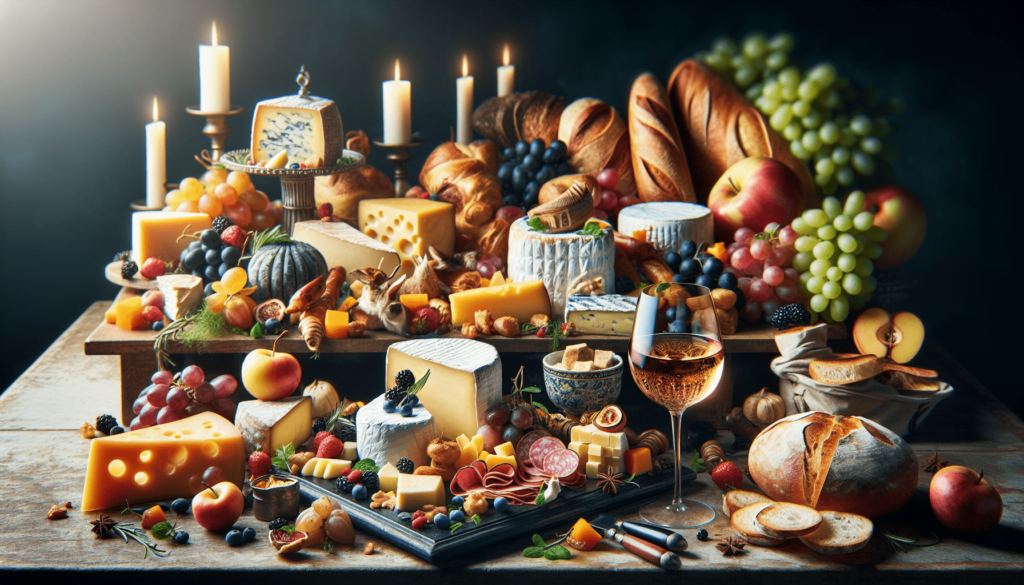Welcome to “Food Lover’s Paradise: A Gastronomic Getaway,” where your culinary dreams come to life through an exploration of diverse and delectable food-centric travel experiences. Imagine embarking on a journey that tantalizes your taste buds with every stop, from bustling street markets brimming with fresh, exotic flavors to Michelin-starred restaurants showcasing innovative gastronomic artistry.
This article delves into the historical roots of gastronomic travel, tracing its evolution from ancient spice trade routes to today’s luxury food tours, and highlights the current trends that make it a must-do for any foodie. You’ll gain insights into key concepts like farm-to-table dining and sustainable sourcing, and read about real-life examples that illustrate the rich tapestry of experiences awaiting you. As we navigate this delicious landscape, you’ll also see a balanced comparison of differing viewpoints on food tourism, assess its impacts, and look ahead to future trends.
Whether you’re a seasoned epicurean or a curious newcomer, this article promises to enrich your understanding and ignite your passion for gastronomic adventures. Have you ever dreamt of embarking on a vacation solely dedicated to your love for food? Imagine exploring a new destination where every meal is an adventure, and every dish tells a unique story. Welcome to the world of gastronomic getaways, where your palate is your guide, and every bite becomes a cherished memory.
Table of Contents
Overview
In recent years, the concept of gastronomic getaways has captivated the hearts of travelers and food enthusiasts alike. These trips blend the joy of travel with the pleasure of culinary experiences, creating unforgettable journeys that satisfy both your wanderlust and your appetite. As we delve into the fascinating realm of food-focused travel, we’ll explore its history, current trends, and future directions, offering a comprehensive guide to creating your very own food lover’s paradise.
Historical Context
The allure of food-based travel isn’t a new phenomenon. Since ancient times, people have traveled far and wide in search of exotic spices, rare ingredients, and unique culinary techniques. Explorers like Marco Polo and Ibn Battuta set out on ambitious voyages, driven by their fascination with foreign flavors. The Silk Road, a network of trade routes connecting the East and West, played a pivotal role in the exchange of culinary traditions, profoundly influencing global cuisines.
In the modern era, the rise of gastronome travelers can be traced back to the post-World War II boom, when disposable incomes increased, and air travel became more accessible. Europe’s wine regions, such as Bordeaux and Tuscany, attracted connoisseurs eager to savor fine wines and local dishes. Thus, the seeds of gastronomic travel were sown, and they have since grown into a full-fledged trend.

Current Trends
Today, gastronomic getaways are more popular than ever. The rise of food tourism can be attributed to several factors, including the growth of social media, the increasing global curiosity about different cultures, and the desire for authentic experiences. Travelers now choose their destinations based on culinary reputations, seeking out everything from street food stalls in Bangkok to Michelin-starred restaurants in Paris.
Farm-to-Table Movement
One prominent trend is the farm-to-table movement, which emphasizes locally sourced ingredients and sustainable practices. This approach not only supports local farmers but also offers travelers a deeper connection to the land and the people who cultivate it. Whether you’re dining at a chic urban eatery or a rustic countryside inn, farm-to-table experiences provide a fresh and ethical take on culinary tourism.
Food Festivals
Food festivals have also become major attractions for gastronomic travelers. From the glitzy Food and Wine Festival in Miami to the culturally rich Harbin International Ice and Snow Sculpture Festival in China, these events offer a smorgasbord of flavors and experiences. They provide a unique opportunity to sample a region’s specialties, meet renowned chefs, and immerse yourself in the local food culture.
Key Concepts and Definitions
Before we dive deeper, let’s clarify some key concepts. Understanding these terms will enhance your appreciation and participation in gastronomic getaways.
Gastronomic Getaway
A gastronomic getaway refers to a vacation where the primary focus is exploring and experiencing the local food culture. This type of travel often includes visits to famous restaurants, local markets, food festivals, wineries, and farms.
Culinary Tourism
Culinary tourism, also known as food tourism, involves traveling to a particular destination primarily to experience its culinary offerings. This can include cooking classes, food tours, and tastings, aiming to provide an authentic taste of the local cuisine.
Farm-to-Table
Farm-to-table is a dining approach that emphasizes sourcing ingredients directly from local farms, ensuring freshness and supporting sustainable practices. This concept is pivotal in many gastronomic getaways, particularly in rural and agricultural regions.

Detailed Exploration
Let’s delve into the specific components that make up a successful gastronomic getaway.
Selecting Your Destination
When planning a gastronomic getaway, selecting the right destination is key. Consider what excites your palate. Are you drawn to the aromatic spices of Southeast Asia, the rich umami flavors of Japan, or perhaps the robust wines and cheeses of Europe? Each region offers its own unique culinary experience.
Researching Local Dishes
Before you go, it’s beneficial to research the must-try dishes of your chosen destination. Knowing what to look for can enhance your experience and ensure you don’t miss out on any culinary highlights. Make a list of traditional foods, seasonal specialties, and local eateries to visit.
Immersive Culinary Activities
Engage in immersive culinary activities to deepen your connection to the local food culture. Cooking classes, food tours, and visits to local farms or markets provide hands-on experiences that are both educational and enjoyable. You’ll learn about the origins of the dishes and the techniques used to prepare them, gaining a greater appreciation for the cuisine.
Example 1: A Journey Through Italy
Imagine embarking on a gastronomic journey through Italy. Start in the north, in the Piedmont region, renowned for its truffles and Barolo wine. Visit local markets in Alba, and attend a truffle hunting excursion to understand the intricacies of this prized ingredient.
Traveling south, stop in Bologna, the heart of Italian cuisine. Take a pasta-making class to master the art of crafting fresh pasta from scratch. Sample classic dishes like tagliatelle al ragù and tortellini in brodo.
Conclude your journey in Sicily, where the vibrant flavors of arancini, cannoli, and fresh seafood await. A visit to a Sicilian farm offers a farm-to-table experience, allowing you to taste olive oils, cheeses, and wines produced on-site.
Example 2: The Flavors of Japan
Japan offers another enticing example of a gastronomic getaway. Begin in Tokyo, home to the most Michelin-starred restaurants in the world. Explore bustling Tsukiji Fish Market, where you can sample the freshest sushi straight from the source.
Head west to Kyoto, famous for its kaiseki cuisine – a multi-course dining experience showcasing seasonal ingredients. Attend a tea ceremony to learn about the significance of matcha in Japanese culture.
Venture further to the island of Hokkaido, known for its dairy products, seafood, and ramen. Participate in a cooking class to make miso ramen and enjoy tasting local delicacies like grilled hokke (mackerel).
Comparison of Different Perspectives
There are diverse perspectives on the impact and value of gastronomic getaways. Some argue that food tourism boosts local economies by attracting visitors who spend money on dining, lodging, and activities. This influx of tourism revenue can lead to improved infrastructure and increased visibility for smaller communities.
Economic Benefits
Proponents emphasize the economic benefits of gastronomic tourism. Local farmers, chefs, and artisans gain exposure and business, fostering a sense of community pride and sustainability. Regions famous for their cuisine, like Napa Valley for wine or Provence for lavender and truffles, see a steady stream of tourists eager to experience these specialties.
Cultural Exchange
Others highlight the role of food tourism in promoting cultural exchange. When travelers engage with local chefs, farmers, and food artisans, they gain insights into the cultural heritage and culinary traditions of the region. This fosters mutual respect and appreciation between different cultures.
Environmental Concerns
However, critics point out potential downsides, particularly concerning environmental impact. Increased tourism can lead to overconsumption of resources, pollution, and disruption of local ecosystems. It’s crucial for gastronomic tourists to adopt sustainable practices, such as supporting eco-friendly establishments and minimizing waste.
Impact Assessment
Evaluating the impact of gastronomic getaways involves a balanced analysis of both their positive and negative aspects. While these trips undeniably offer economic and cultural benefits, they also carry environmental responsibilities that travelers and hosts must consider.
Economic Impact
The tourism industry significantly benefits from gastronomic travel, with local economies receiving a boost from the influx of visitors. Small businesses, in particular, thrive as tourists seek out unique, authentic culinary experiences.
Cultural Impact
Culinary tourism enhances cultural exchange, fostering deeper understanding and respect for diverse traditions. Through food, travelers can connect with the history and customs of a region, creating lasting impressions and fostering global unity.
Environmental Impact
The environmental footprint of increased tourism requires mindful management. Sustainable practices, such as supporting local, organic farms and minimizing single-use plastics, are essential for preserving the natural beauty and resources of gastronomic destinations.
Future Directions and Implications
As the popularity of gastronomic getaways continues to grow, several trends and future directions are likely to shape this industry.
Predictions
Looking ahead, we can anticipate a rise in eco-friendly and sustainable culinary tourism. Travelers are becoming more conscious of their environmental impact and seeking out destinations that prioritize sustainability. Expect to see more farm-to-table restaurants, organic vineyards, and eco-friendly accommodations.
Another prediction is the increasing integration of technology in food tourism. Virtual reality (VR) may offer pre-trip culinary experiences, allowing travelers to explore a destination’s food scene from their homes. Additionally, apps and online platforms will continue to connect travelers with local dining experiences, ensuring a smooth and personalized journey.
Implications
The implications of these trends are far-reaching. The emphasis on sustainability will drive innovation in agricultural practices, leading to more environmentally friendly food production. The integration of technology will enhance accessibility, allowing more people to participate in gastronomic getaways and fostering a greater appreciation for global cuisines.
For society, the rise of culinary tourism represents a shift towards valuing experiences over materialistic pursuits. As people prioritize memorable, meaningful journeys, the tourism industry will evolve to meet these desires, offering richer, more immersive experiences.
Conclusion
As we’ve explored, gastronomic getaways offer a delightful blend of travel and culinary adventures, making them an irresistible option for food lovers. From their historical roots to their current trends and future possibilities, these trips provide a unique way to discover the world through its flavors.
In this food lover’s paradise, every bite is a new discovery, and every meal is a story waiting to be told. So, whether you’re meandering through the vineyards of Bordeaux or savoring sushi in Tokyo, remember that the journey is just as important as the destination. Bon appétit and happy travels!
If this article has sparked your appetite for adventure, please share your thoughts or experiences in the comments below. And don’t forget to explore more resources for planning your perfect gastronomic getaway.
Credible Sources
- Barber, Dan. “The Third Plate: Field Notes on the Future of Food.” Penguin Press, 2014.
- Dornenburg, Andrew, and Karen Page. “The Flavor Bible: The Essential Guide to Culinary Creativity, Based on the Wisdom of America’s Most Imaginative Chefs.” Little, Brown, 2008.
- Hesser, Amanda. “The Essential New York Times Cookbook: Classic Recipes for a New Century.” W. W. Norton & Company, 2010.
- Scarpato, Rosario, and Chris K Pfeiffer. “Culinary Tourism: Proceedings of the International Conference.” Haworth Press, 2003.
- United Nations World Tourism Organization (UNWTO). “Global Report on Food Tourism.” UNWTO, 2012.
A Food Lover’s Paradise: Discovering Poole’s Gastronomic Delights
Taste Travels: A Delicious Journey Across International Cuisine
